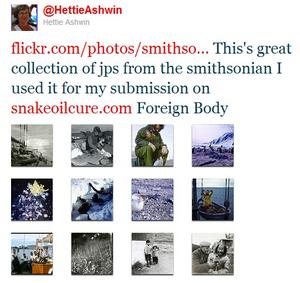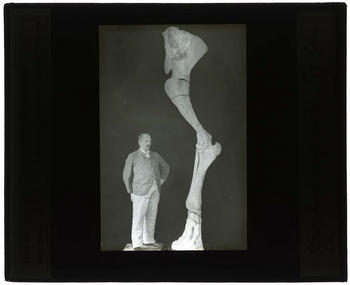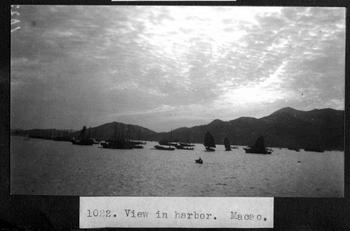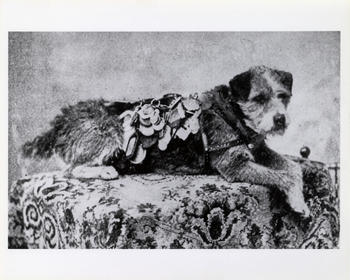The other day I noticed the following tweet from Hettie Ashwin about the Smithsonian Flickr Commons, which immediately caught my eye:
Ashwin had been using images from the Smithsonian's Commons stream to inspire her creative writing. I was really excited to see this and hopped over to Dr. Hurley’s Snake-Oil Cure, the online journal of “fiction, photography, comic strips, art, reviews, opinions, and tonics,” she mentioned in her tweet, to see the writing.
To my utter delight, I found that the journal was featuring a whole series of creative writings based on Smithsonian photographs.
For example, one of Ashwin’s own writings, “Foreign Body,” features the image above from our collections, and begins ominously:
“The effort was enormous but the rewards worth it. He knew it was never part of him. A foreign body, sapping him, draining his will to go on.”
Intrigued as I was, I was able to speak with Hettie Ashwin over email about her involvement in the Smithsonian writing project at Snake Oil. She noted that the Smithsonian project had piqued her interest, and so she began exploring the Flickr photographs, adding “When I saw the right leg my story just seemed to fit and there you have it.”
Another piece, a poem by John Collard called “Macau Harbor” illustrated with an image of that locale from the Archives’ collections, describes the sweeping view:
It lay like a protected virgin;
serenely composed in a sepia dawn,
marbled clouds playing Chinese whispers
amongst low-slung hills.
Other pieces dig directly into the Smithsonian’s history and the context of the photo itself, like J.W. Rogers’ short story, “The Death of Owney.” In Rogers’ story, a character describes the dog, Owney:
“Brand returned to his desk, where he mused on the odd quality of this dog that travelled from post station to post station, unfettered, on his own whim, disrupting and enlivening.”
As you may know, Owney was a dog who became a regular fixture at a New York post office in 1888, and later began to ride with mail bags on Railway Post Office (RPO) train cars across the country and the world. Owney now resides at the Smithsonian’s National Postal Museum.
 I was able to get in touch with Snake Oil editors and co-founders, Emily Jones & Daniel Le Ray to learn more about the Smithsonian project, and what inspired them to use photos as a part of the creative writing process. The journal publishes all types of writing—as Le Ray put it: “anything that is both good and interesting.” Jones, an amateur photographer who spends a lot of time on Flickr, stumbled upon the Smithsonian Flickr stream while searching for photography to feature in the journal. She remarks, “the . . . stream was like a curiosity cabinet—every set is full of inspiring photos, some beautiful, some bizarre—and I thought that if I find them so inspiring, surely some of our contributors would as well. And so the idea for the series was born.”
I was able to get in touch with Snake Oil editors and co-founders, Emily Jones & Daniel Le Ray to learn more about the Smithsonian project, and what inspired them to use photos as a part of the creative writing process. The journal publishes all types of writing—as Le Ray put it: “anything that is both good and interesting.” Jones, an amateur photographer who spends a lot of time on Flickr, stumbled upon the Smithsonian Flickr stream while searching for photography to feature in the journal. She remarks, “the . . . stream was like a curiosity cabinet—every set is full of inspiring photos, some beautiful, some bizarre—and I thought that if I find them so inspiring, surely some of our contributors would as well. And so the idea for the series was born.”
Of course, the idea of using visual imagery to inspire writing and even break writer’s block is not out of the ordinary. But Le Ray notes that photographs can be an especially powerful tool: since many writings “have their origins in tiny observances or thoughts that pop up from day to day,” it follows that “when you place a photograph in front of writerly sorts, you almost provide that small observance or thought.” We at the Archives have found the Snake Oil Smithsonian project so special—because while the visual may inspire writing, it’s not often that we are privy to how our collections may inspire the public’s creative pursuits in deep and unexpected ways.
 It’s especially rewarding to see our collections reach those across the world who may not have a chance to come to the Smithsonian in person. Snake Oil writer Ashwin remarked that as she lives on a yacht in Australia and is a self-proclaimed museum junkie, “having the www is just about the best I can get sitting still.” And journal co-founder Jones makes another great point—so often the objects found in cultural institutions are isolated from other creative formats or forms of expression, and indeed, our experience of museums is often isolated from the everyday. She explains: “I don’t believe the media should be isolated from one another. What I’d like to see is a museum that places text in a frame alongside the artwork, or a library that puts artwork on the shelves. I also think that ‘Art’ should be accessible. I don’t think that you should have to be ‘in the mood’ to go to a museum. I think it should be a part of everyday life—moments of beauty make otherwise dull days more enjoyable, no matter what form the beauty takes, be it a jewel-like poem, a dark, but well-crafted story, or an image.” That is exactly why we share our images on the Flickr Commons, and I truly can’t think of any more exquisite way to put it.
It’s especially rewarding to see our collections reach those across the world who may not have a chance to come to the Smithsonian in person. Snake Oil writer Ashwin remarked that as she lives on a yacht in Australia and is a self-proclaimed museum junkie, “having the www is just about the best I can get sitting still.” And journal co-founder Jones makes another great point—so often the objects found in cultural institutions are isolated from other creative formats or forms of expression, and indeed, our experience of museums is often isolated from the everyday. She explains: “I don’t believe the media should be isolated from one another. What I’d like to see is a museum that places text in a frame alongside the artwork, or a library that puts artwork on the shelves. I also think that ‘Art’ should be accessible. I don’t think that you should have to be ‘in the mood’ to go to a museum. I think it should be a part of everyday life—moments of beauty make otherwise dull days more enjoyable, no matter what form the beauty takes, be it a jewel-like poem, a dark, but well-crafted story, or an image.” That is exactly why we share our images on the Flickr Commons, and I truly can’t think of any more exquisite way to put it.
Check out the dozens of other stories inspired by Smithsonian Flickr Commons images on the journal’s website, and take note, submissions of your own prose, poetry, audio, or visual art inspired by the Smithsonian Flickr Commons are welcomed—email submissions to the journal at: snakeoilcure [at] gmail [dot] com.
Produced by the Smithsonian Institution Archives. For copyright questions, please see the Terms of Use.





Leave a Comment